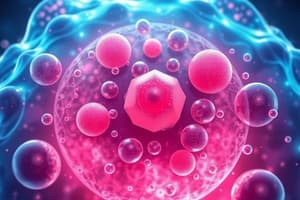Podcast
Questions and Answers
Which of the following may NOT be considered a macromolecule?
Which of the following may NOT be considered a macromolecule?
- Carbohydrate
- Protein
- Lipid (correct)
- Nucleic acid
- All of the above ARE macromolecules
Which of the following best describes nucleic acids?
Which of the following best describes nucleic acids?
- Storage molecules for energy
- Enzymatic molecules
- They are not molecules but compounds
- Hereditary molecules (correct)
- None of the above
Which cellular structure is common to all three domains of life (Archaea, Bacteria, and Eukarya)?
Which cellular structure is common to all three domains of life (Archaea, Bacteria, and Eukarya)?
- Endoplasmic reticulum
- Endocytotic vesicles
- Nucleus
- Mitochondria
- Phospholipid bilayer cell membrane (correct)
What is the primary function of ribosomes?
What is the primary function of ribosomes?
Which of the following statements differentiates a prokaryotic cell from a eukaryotic cell?
Which of the following statements differentiates a prokaryotic cell from a eukaryotic cell?
Which of the following describes the function of the plasma membrane?
Which of the following describes the function of the plasma membrane?
Why do cells tend to be small?
Why do cells tend to be small?
What is the function of the nuclear envelope?
What is the function of the nuclear envelope?
Where does the modification and sorting of proteins and lipids occur?
Where does the modification and sorting of proteins and lipids occur?
Which organelle is responsible for degrading and recycling cellular waste?
Which organelle is responsible for degrading and recycling cellular waste?
What is the role of vacuoles in plant cells?
What is the role of vacuoles in plant cells?
What is the endosymbiotic theory?
What is the endosymbiotic theory?
Which of the following is NOT considered an argument that supports mitochondria evolving from prokaryotic endosymbionts?
Which of the following is NOT considered an argument that supports mitochondria evolving from prokaryotic endosymbionts?
What is the primary source of energy for cellular respiration?
What is the primary source of energy for cellular respiration?
What is the function of chloroplasts?
What is the function of chloroplasts?
In what cells are chloroplasts found?
In what cells are chloroplasts found?
What is the main function of peroxisomes?
What is the main function of peroxisomes?
Which of the following describes the function of the cytoskeleton:
Which of the following describes the function of the cytoskeleton:
What are the three main types of fibers that make up the cytoskeleton?
What are the three main types of fibers that make up the cytoskeleton?
What is the function of motor proteins in the cell?
What is the function of motor proteins in the cell?
What role do microtubules play in cell division?
What role do microtubules play in cell division?
What are centrioles composed of, and what is their arrangement?
What are centrioles composed of, and what is their arrangement?
What is the function of the basal body in cilia and flagella?
What is the function of the basal body in cilia and flagella?
What protein is responsible for the movement of cilia and flagella?
What protein is responsible for the movement of cilia and flagella?
What is the function of microfilaments in cellular motility?
What is the function of microfilaments in cellular motility?
Which protein do microfilaments need, in addition to action, to function in cellular motility?
Which protein do microfilaments need, in addition to action, to function in cellular motility?
What are the defining characteristics of intermediate filaments?
What are the defining characteristics of intermediate filaments?
What is the function of the cell wall in plant cells?
What is the function of the cell wall in plant cells?
What is the composition of plant cell walls?
What is the composition of plant cell walls?
How do plant cells communicate with each other?
How do plant cells communicate with each other?
What are the primary constituents of the extracellular matrix (ECM) in animal cells?
What are the primary constituents of the extracellular matrix (ECM) in animal cells?
What is the function of integrins in the ECM?
What is the function of integrins in the ECM?
Which type of intercellular junction prevents leakage of extracellular fluid across a layer of epithelial cells?
Which type of intercellular junction prevents leakage of extracellular fluid across a layer of epithelial cells?
What do desmosomes do?
What do desmosomes do?
What is the function of gap junctions?
What is the function of gap junctions?
Which type of light microscopy provides sharper images of three-dimensional tissues and cells?
Which type of light microscopy provides sharper images of three-dimensional tissues and cells?
You want to visualize the fine details of the ribosomes of a cell. Which microscope is most suited for this purpose?
You want to visualize the fine details of the ribosomes of a cell. Which microscope is most suited for this purpose?
Enzymes responsible for biosynthesis of membrane lipids are located in what part of an animal cell?
Enzymes responsible for biosynthesis of membrane lipids are located in what part of an animal cell?
Flashcards
Magnification
Magnification
The ratio of an object's image size to its real size.
Resolution
Resolution
The measure of the clarity of an image; the minimum distance two points can be separated and still be distinguished.
Contrast
Contrast
Visible differences in parts of the sample.
Scanning Electron Microscope (SEM)
Scanning Electron Microscope (SEM)
Signup and view all the flashcards
Transmission Electron Microscope (TEM)
Transmission Electron Microscope (TEM)
Signup and view all the flashcards
Cell
Cell
Signup and view all the flashcards
Prokaryotic Cell
Prokaryotic Cell
Signup and view all the flashcards
Nucleoid
Nucleoid
Signup and view all the flashcards
Eukaryotic Cell
Eukaryotic Cell
Signup and view all the flashcards
Plasma membrane
Plasma membrane
Signup and view all the flashcards
Cytosol
Cytosol
Signup and view all the flashcards
Nucleus
Nucleus
Signup and view all the flashcards
Ribosomes
Ribosomes
Signup and view all the flashcards
Nucleus
Nucleus
Signup and view all the flashcards
Endomembrane system
Endomembrane system
Signup and view all the flashcards
Endoplasmic Reticulum (ER)
Endoplasmic Reticulum (ER)
Signup and view all the flashcards
Smooth ER
Smooth ER
Signup and view all the flashcards
Rough ER
Rough ER
Signup and view all the flashcards
Golgi apparatus
Golgi apparatus
Signup and view all the flashcards
Lysosome
Lysosome
Signup and view all the flashcards
Phagocytosis
Phagocytosis
Signup and view all the flashcards
Autophagy
Autophagy
Signup and view all the flashcards
Vacuoles
Vacuoles
Signup and view all the flashcards
Mitochondria
Mitochondria
Signup and view all the flashcards
Chloroplasts
Chloroplasts
Signup and view all the flashcards
Endosymbiont Theory
Endosymbiont Theory
Signup and view all the flashcards
Peroxisomes
Peroxisomes
Signup and view all the flashcards
Cytoskeleton
Cytoskeleton
Signup and view all the flashcards
Motor proteins
Motor proteins
Signup and view all the flashcards
Microtubules
Microtubules
Signup and view all the flashcards
Centrosome
Centrosome
Signup and view all the flashcards
Cilia and Flagella
Cilia and Flagella
Signup and view all the flashcards
Microfilaments (Actin Filaments)
Microfilaments (Actin Filaments)
Signup and view all the flashcards
Cytoplasmic Streaming
Cytoplasmic Streaming
Signup and view all the flashcards
Pseudopodia
Pseudopodia
Signup and view all the flashcards
Intermediate Filaments
Intermediate Filaments
Signup and view all the flashcards
Extracellular Matrix (ECM)
Extracellular Matrix (ECM)
Signup and view all the flashcards
Cell Wall
Cell Wall
Signup and view all the flashcards
Plasmodesmata
Plasmodesmata
Signup and view all the flashcards
Tight Junctions
Tight Junctions
Signup and view all the flashcards
Signup and view all the flashcards




